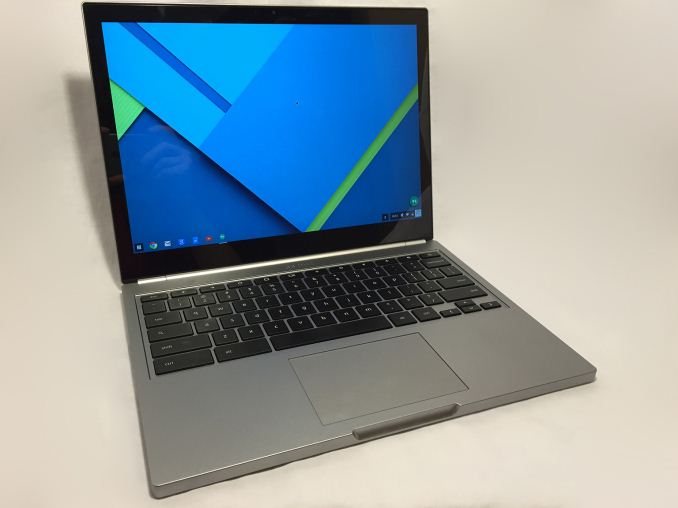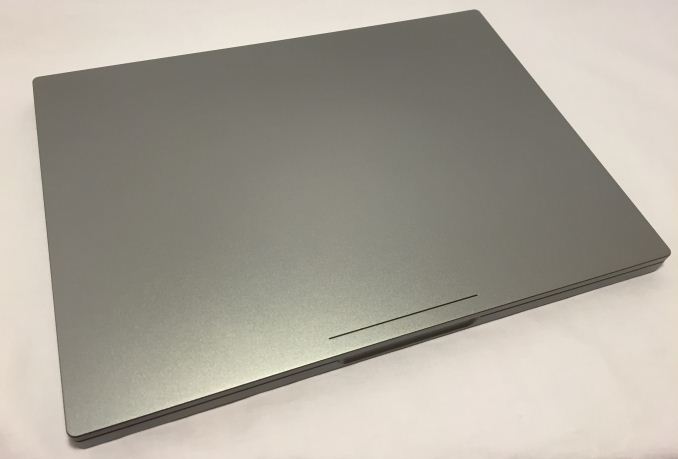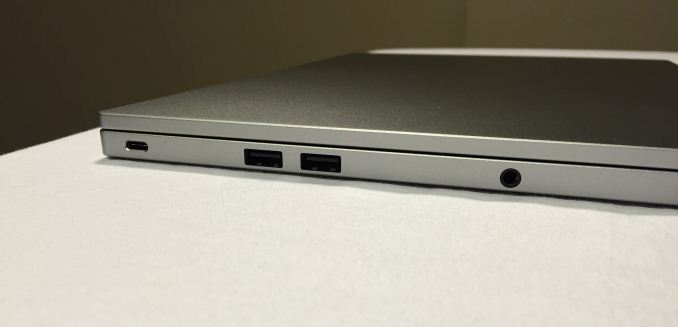The Chromebook Pixel (2015) Review
by Brandon Chester on March 16, 2015 8:00 AM EST- Posted in
- Laptops
- Chrome OS
- Chromebook
- Chromebook Pixel

Google's Chrome OS has always been similar to Microsoft Windows in how one company provides the operating system for many different manufacturers to use on their own devices. But two years ago, Google decided to create a Chromebook which was solely Google branded and designed. Although Chromebooks typically aim at the inexpensive part of the laptop market, this Google branded Chromebook had specifications that put it in line with high end Ultrabooks, and an equally high price tag. It was the original Chromebook Pixel, and its name referred to its 2560x1700 IPS display. At 239ppi it had the highest pixel density of any laptop in the world when it was released, and the rest of its specs were also impressive. In our original review of it, we concluded that it was an impressive laptop, but that its starting price of $1299 was quite a barrier to entry. In addition Chrome OS was more limited at that time than it is today.
That brings us to the new Chromebook Pixel which was released just last week. At first glance, you would be hard pressed to tell the difference between this new model and the old one. It has a similar high resolution display, and the same aluminum body with flat edges. But a look at the sides of the chassis will reveal a pair of highly versatile USB Type-C ports, and a figurative look inside will show one of Intel's new Broadwell CPUs which enables high performance and stellar battery life. Before we dive into the new Chromebook Pixel, I've compared it with the original Pixel from 2013 in the chart below.
| Chromebook Pixel (2013) | Chromebook Pixel (2015) | Chromebook Pixel LS | |
| Dimensions | 11.72 x 8.84 x 0.64" (297.7 x 224.5 x 16.3mm) | ||
| Mass | 3.35 lbs (1.52kg) | ||
| CPU | Core i5-3337U (2 cores + HT) | Core i5-5200U (2 cores + HT) | Core i7-5500U (2 cores + HT) |
| L3 Cache | 3MB | 3MB | 4MB |
| Base CPU Clock | 1.8GHz | 2.2GHz | 2.4GHz |
| Max CPU Turbo | 2.7GHz | 2.7GHz | 3.0GHz |
| GPU | Intel HD 4000 | Intel HD 5500 | Intel HD 5500 |
| System Memory | 4GB DDR3L-1600 | 8GB LPDDR3-1600 | 16GB LPDDR3-1600 |
| Storage | 32GB SSD | 32GB SSD | 64GB SSD |
| Display | 12.85" 2560x1700 IPS LCD | ||
| Battery | 59 Wh | ||
| Ports | 2 x USB 2.0, Mini DisplayPort, 3.5mm audio | 2 x USB Type-C, 2 x USB 3.0, 3.5mm audio, SD card | |
| Connectivity | 2x2 802.11a/b/g/n + BT 3.0 | 2x2 802.11a/b/g/n/ac + BT 4.0 | |
| Launch Price | $1299 | $999 | $1299 |
Some investigation into the Pixel's hardware reveals a few more details about it. The version sent by Google was the normal Intel i5 model, and although I don't expect the suppliers would be different for parts of the "Ludicrous Speed" model, it's still possible. In addition, parts like the RAM and SSD could be sourced from multiple vendors, although this is again unlikely due to the relatively small number of units that will be manufactured.
The original Pixel used a Sandisk iSSD, while this new Pixel uses an SSD made by Kingston. It's likely that it's still soldered to the motherboard which makes replacing or upgrading it impossible. Given that the Pixel can only be disassembled using suction cups and a great deal of force I'm not able to actually look inside to check. In addition, the i5 model of the Pixel uses two 4GB LPDDR3 modules which are manufactured by Samsung.
The chassis of the new Pixel is just as impressive as the previous model. The aluminum construction feels incredibly solid, and is heavy but not excessively so. When you first look at it, you'll notice that the device itself is slightly more square than other laptops, as a result of its 3:2 display. This square profile also extends to the sides and edges of the Pixel, which are as flat as can be. The top of the device also retains the LED light bar from the original model, which lights up in green, yellow, red, and blue colors and has a very Googley feel to it. Tapping twice on the top of the laptop will cause some of the LEDs on the light bar to turn on, and the color and number of LEDs gives you an approximation of how much battery life you have left. All these little details result in a really unique design, and its been clear since the original Pixel that Google wanted to create their own device instead of just carbon copying another laptop
Upon opening the Pixel, you'll be greeted by a uniquely shaped LCD display surrounded by a fairly thin bezel. Beneath it are the keyboard and touchpad, both of which felt great to use. The keyboard had a comfortable amount of key travel, very little movement back and forth, and large well spaced key caps that made typing a breeze. The keyboard also acts as the vent for the Pixel's fans, and the speakers are hidden underneath. Google uses sensors to detect when your hands are over the keys, and so the keyboard backlight is only on when you're typing. The touchpad is covered by a smooth piece of glass, and it was responsive and accurate in use, which is something that can't be said about many other laptops regardless of price. One small complaint I have is that Chrome OS doesn't seem to support pinch to zoom on the touchpad. If it does, I certainly couldn't find the option anywhere I looked.
That brings us back to the display, which is a 3:2 touch enabled IPS LCD. Chrome OS seemed reasonably responsive using the touchscreen, although much like on Android multi-touch gestures like pinch to zoom didn't track well to how your fingers were actually moving inward and outward. I don't think that the touchscreen is really a necessary input method on a laptop, and in my experience it's not comfortable in the slightest to hold your arm up and poke at your laptop display, but the option is there for users who desire it. Google has also improved the display hinge to reduce the bounce back of the display when touching it.
The sides of the pixel have all of the ports for expansion. Google clearly believes that users enjoy having ports on their laptops, and so each side of the Pixel has a USB 3.0 Type-C port, along with two USB 3.0 Type-A ports and an audio jack on the left side, and an SD card slot on the right side. Google provides several adapters that can be used to transform the Type-C ports to other existing interfaces, including HDMI, DisplayPort, and both female and male USB Type-A.
The build quality of the Chromebook Pixel certainly inspires a great deal of confidence in the rest of the machine, so lets continue our examination of the new Pixel with a look at the improvements Google has made to the display.













123 Comments
View All Comments
jimbo2779 - Tuesday, March 17, 2015 - link
You cannot ski 24/7, also kids tend to enjoy watching things they like while their parents sit around and have a relaxing drink.Face it 32GB is a tiny amount, especially when you are splashing this much cash for a laptop, it is absolutely inexcusable. There are so many scenarios where you would want some media on the machine and you would easily fill this up. Having to lug around extra USB drives to ensure you have enough storage when away from a net connection is just not as convenient.
Relying on cloud or NAS for your media is fine if you never leave your home or office but when you are out and about you need LTE for full coverage and not only does this cost more you are not always covered when not in a city and coverage can be spotty when you do have it.
On top of this there is the argument of relying on cloud storage which is great until they start charging for it after a few years so something that could have been added in the high price of your laptop is now costing real money.
Again, 32Gb at this price point is inexcusable, there are many reasons as to why.
armwood - Sunday, September 20, 2015 - link
It seems that so many people do not understand the concept of the Chrome operating system. It is a cloud system. Wifi is most places and where it is not either carry a hotspot or tether your phone. It is not rocket science. Google Drive or Dropbox can whole all of your data with movies etc on an SD card. Wake up, this is the future of computing. It amazes me how shortsighted so many people are.armwood - Sunday, September 20, 2015 - link
You need to spend a fee days with a Chromebook Pixel 2 LS. I use it and leave my Macbook Pro and Surface Pro 3 on my desk. I take it and use it for my college lectures over the other two machines. It is a superb, fast device that works in environments with weaker wifi signals better than Apple or Windows computers.jabber - Wednesday, March 18, 2015 - link
I've been using my Chrombook for over 2 years now. No user data has ever touched the 16GB SSD in it in all that time.I don't get the love for 'big data'. Just seems like tying yourself down to a huge anchor.
armwood - Sunday, September 20, 2015 - link
It seems that so many people do not understand the concept of the Chrome operating system. It is a cloud system. Wifi is most places and where it is not either carry a hotspot or tether your phone. It is not rocket science. Google Drive or Dropbox can whole all of your data with movies etc on an SD card. Wake up, this is the future of computing. It amazes me how shortsighted so many people are.psychobriggsy - Monday, March 16, 2015 - link
There's a lot to like about this product - especially the hardware and design.If it came with a 256GB SSD with Crouton pre-installed, that would have been great. 32/64GB isn't enough so you'd need to spend more on replacing this - a build option would be great. Yeah, I know this doesn't fit into Google's concept of a computing device.
The touchscreen is a bit pointless, unless they had made the device more Yoga-like, with a tablet folding mode.
In terms of hardware design, this is up there with the best. Other OEMs can learn a lot from this, for their non-Air-ripoff designs.
Hanoveur - Monday, March 16, 2015 - link
You can buy a 256gb XDSC card and plug that into it.jimbo2779 - Tuesday, March 17, 2015 - link
And spend more money fixing something that should not be an issue, sounds like a great solution.Also it is easy to lose a memory card, especially when kids are around. Built in storage is slightly harder to lose
steven75 - Wednesday, March 18, 2015 - link
Did you just bring up Flash player in 2015?djw39 - Monday, March 16, 2015 - link
But that "real computer" can be old and cheap. For example, I have a desktop PC I got 10 years ago for $500, anything the chromebook can't do due to limitations of the OS can theoretically be done on the desktop. In real life I almost never use the desktop.Now, I fully admit, I'd take an orange-and-white plastic version for $500-600. But I think a high-resolution screen and Core i5 sounds about right for the hardware.